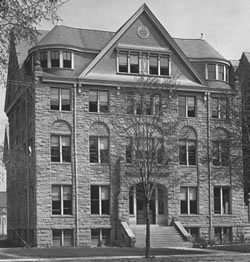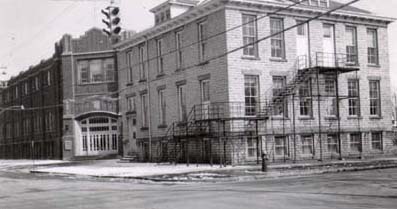|























| |
|
Put-in-Bay:
Perry's
Victory and International Peace Memorial, Put-in-Bay "A separate contract
was awarded by the Inter-State Board to John H. Feick, a local
contractor from Sandusky, Ohio. Feick was selected to clear the
construction site, which was actually a wooded swamp. On 24 June 1912
the first spade of earth was turned, and the 75 year dream was about to
be fulfilled." - http://www.nps.gov/pevi/HTML/monument.html
http://www.bgsu.edu/Colleges/library/cac/ms0632.html
- The small grouping of business correspondence includes a detailed
material costs list from the construction firm of John Feick for
the construction of the Heineman-Schraidt house and barn,
Put-in-Bay.
Formal
Opening of the Lake Laboratory Building -
Opening of the Lake Laboratory Building. 183 .Professor Bradford; the
contractor, Mr. George Feick ; to the. officers of the
Cedar Point Pleasure Resort ...
|
|
Colorado - Sugar City
"(Sandusky, Ohio) ; Bio/History:
Sandusky, Ohio construction company; built the National
Sugar plant at Sugar City, Colorado.
The community was named for its sugar beet factory, which closed in
1967
Developed by the National Beet Sugar Company as a residential community
for its workers
|
|
Oberlin College:
 Rice
Hall, "Constructed
in the years 1909 and 1910 at a cost of $110,000, the building was named
in commemoration of the life services of Professor Fenleon B. Rice and
Mrs. Helen M. Rice. Professor Rice was for thirty-one years the Director
of the Oberlin Conservatory of Music, and to the work of Professor and
Mrs. Rice is due in large measure to the early development, the rapid
growth, and the high artistic ideals of the Conservatory department.
Rice Memorial Hall when it was a conservatory, was a four-story
structure containing six large lecture rooms, numerous studios, and over
a hundred practice rooms. It was used exclusively for the work of the
Conservatory. The architect of the building was Mr. A.B. Jennings of New
York, and it was erected by Mr. George Feick of Sandusky." Rice
Hall, "Constructed
in the years 1909 and 1910 at a cost of $110,000, the building was named
in commemoration of the life services of Professor Fenleon B. Rice and
Mrs. Helen M. Rice. Professor Rice was for thirty-one years the Director
of the Oberlin Conservatory of Music, and to the work of Professor and
Mrs. Rice is due in large measure to the early development, the rapid
growth, and the high artistic ideals of the Conservatory department.
Rice Memorial Hall when it was a conservatory, was a four-story
structure containing six large lecture rooms, numerous studios, and over
a hundred practice rooms. It was used exclusively for the work of the
Conservatory. The architect of the building was Mr. A.B. Jennings of New
York, and it was erected by Mr. George Feick of Sandusky."
"Carnegie
Library was the main campus library. Everyone had to come here
at some point. The first floor contained rooms for special classes of
readers [one was the reserve room where books that a whole class had to
read were on reserve (could not be taken out of the library); another
was the local town library with general fiction], and a cloak room. A
large reading room, 132 by 48 feet, extended across the entire second
floor front of the building, which, with the adjoining alcove,
accommodated two hundred and eighty-four readers. Also on the second
floor were offices, a biographical library room, the cataloguing room.
This was where you went to look up stuff in the card catalog or on
microfiche. The third and fourth floor housed 15 seminar rooms.
Adjoining all floors were the stacks, six stories in height. This was
where you did your research or went to study especially if the main
reading room was too noisy for you. Carnegie Library was the gift of Mr.
Andrew Carnegie, of New York. The total cost in 1907-1908 was $155,600
of which amount Mr. Carnegie furnished $150,000. The building is 135 by
110 feet and it is made of Amherst sandstone. (Amherst is a nearby
community up by Lake Erie.) Messers, Patton and Miller, of Chicago, were
the architects, and the building was constructed by Mr. George Feick,
of Sandusky, Ohio. The building was dedicated June 23, 1908, in
connection with the celebration of the Seventy-fifty Anniversary of the
College."
"The
Finney Memorial Chapel was erected and given to Oberlin College
by Frederic Norton Finney, of Milwaukee, Wisconsin, second son
of Rev. Charles G. Finney, as a monument to his father. It stands
upon the site where Mr. Finney's residence stood for over seventy years.
The Chapel will seat 2000 people and affords standing room for 1000 more
on special occasions, and it is to be used for all purposes to which a
public auditorium is adapted. The architect who designed the Chapel and
supervised its construction was Mr. Cass Gilbert, of New York City. The
builder was George Feick, of Sandusky, Ohio." |
|
Sandusky -

Lutheran
School -
http://www.buildyourownwebsite.org/byow/public/display.asp?key=2623
|
|
http://www.bgsu.edu/colleges/library/cac/ms0681.html
Adam, after working several years as a carpenter with
his brother George, established the firm Adam Feick & Brother in
1872. The business was quite successful and was responsible for several
notable buildings, including Zion Lutheran Church, the Erie
County Jail, buildings at the Ohio Soldiers' and Sailors' Home,
and the Wyoming State Capitol.
|
|
Wyoming - State Capitol
Building
and the State
Capitol at Cheyenne, Wyoming (built in 1886 for
$389,569.13)
"The Dome of the capitol is
real gold leaf. The 24-carat gold leaf dome is visible from all roads
entering the city. it has been gilded six times, the first in 1900 and
the last in 1988. A highly skilled person is needed to put this lead in
place because, if touched by fingers in handling, it will disintegrate.
The peak of the dome is 146 feet high, and the base is 50 feet in
diameter" - http://ai.state.wy.us/capitoltour/Hsitory/index.htm.) |
|